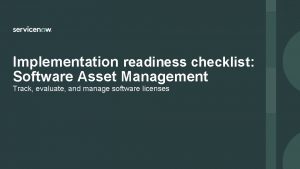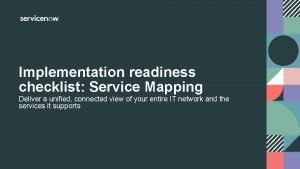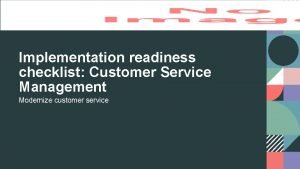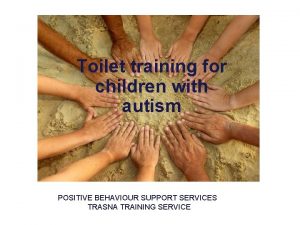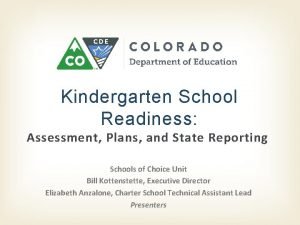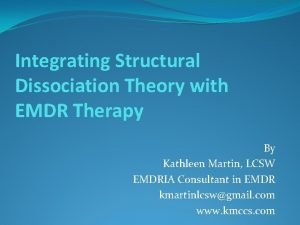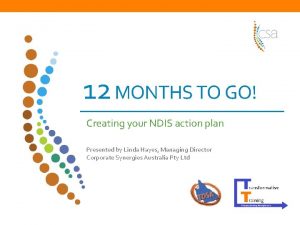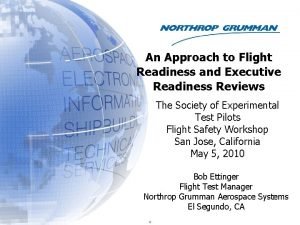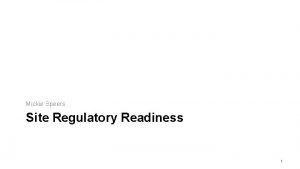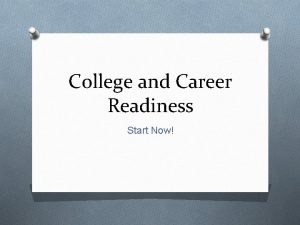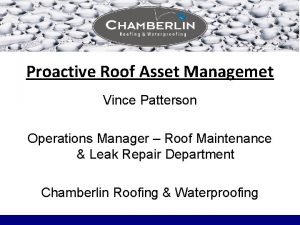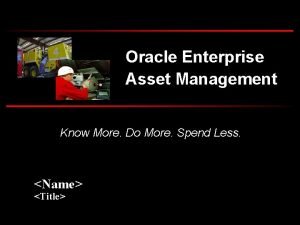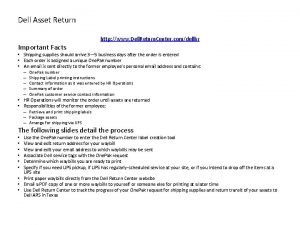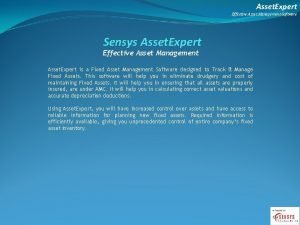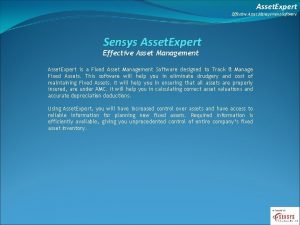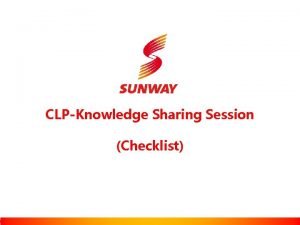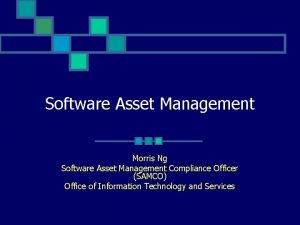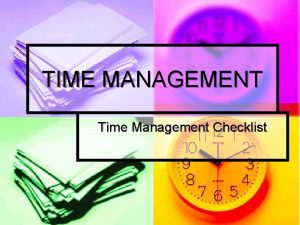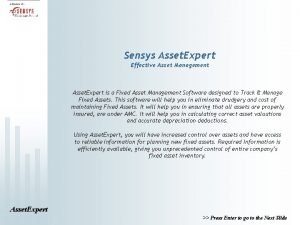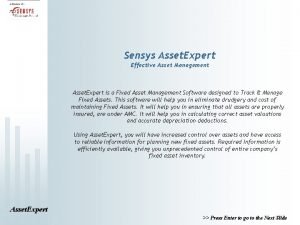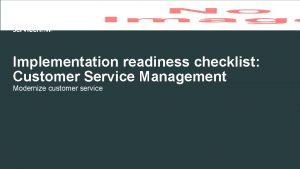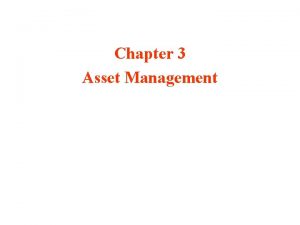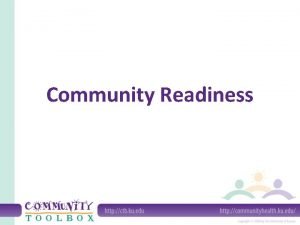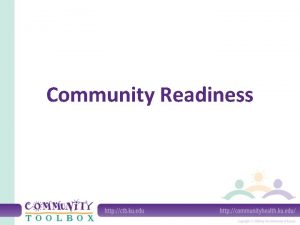Implementation readiness checklist Software Asset Management Track evaluate
















- Slides: 16

Implementation readiness checklist: Software Asset Management Track, evaluate, and manage software licenses

Software Asset Management implementation readiness checklist Introduction Service. Now® Software Asset Management provides immediate and sustaining value by systematically tracking, evaluating, and managing software licenses, compliance, and optimization. You can reclaim unused software rights, purchase new software rights, and manage allocations for entitlements. There are three critical success factors, in addition to the included readiness checklist activities, that are common among customers that have successfully implemented and received value from Software Asset Management: Ø Awareness of key implementation risks and pitfalls, and a plan for prevention Ø Taking the time to create an optimal design based on planned value, which helps you take advantage of new features in future releases Ø Assembling a team with the right skills (including experience with Service. Now Software Asset Management) and sponsorship from at least one executive Technology Process Software Asset Management success 2 People © 2020 Service. Now, Inc. All Rights Reserved.

Software Asset Management implementation readiness checklist Who should read this? The implementation owner, who may be a primary business stakeholder, project manager, or other stakeholder who manages the project and decisionmaking processes Intended use Use this checklist when: • You have a scoped project plan from a Service. Now expert and are using this checklist to prepare, or • You don’t have an implementation project plan yet and are using this checklist to inform your planning efforts This checklist DOES: • Help you align with the Service. Now methodology that will expedite readiness and enhance the design phase • Highlight the standard steps to prepare for implementation • Outline the design phase homework • Prepare you for some of the major decisions you’ll make during implementation design • Prepare you to understand the level of effort and complexity to plan for collecting and cleansing data prior to a Software Asset Management implementation This checklist DOES NOT: • Provide design, configuration, or testing activities – We recommend engaging a Service. Now certified partner or Service. Now Expert Services for planning and assistance with implementation if you don’t have this expertise internally. Note: If you’ve already completed some of the activities on this checklist—such as, defining your business objectives—document those activities before moving on to the next item in the checklist. Key readiness steps 1. Confirm the prerequisites 2. Refine your vision, objectives, and success 4. Create a structure for governance 3. Assess your team readiness 3 5. Plan for OCM activities 6. Plan for implementation design © 2020 Service. Now, Inc. All Rights Reserved.

Checklist: Prepare to implement Software Asset Management Step 1: Confirm the prerequisites See slides 6– 7 to complete this step. q Review Software Asset Management’s functionality to ensure it aligns with business objectives. q q q Confirm CMDB is healthy and discovery sources are set up. Organize team and Software Asset Management data. Engage an implementation team with Service. Now expertise. Step 2: Refine the vision, business objectives, and measures of success See slide 8 to complete this step. q q q Document the key goals such as cost optimization and compliance risk mitigation. Identify potential risks, see examples on slides 14 -15. Confirm how success will be measured and how it will be communicated. Step 3: Assess your team readiness Step 4: Create a structure for governance See slide 10 to complete this step. q Establish an implementation governance committee that is strategic and operational for Software Asset Management. Step 5: Plan for communication and user training See slide 11 to complete this step. q q Build a marketing plan to encourage adoption and explain the benefits. Build a training plan for all user types. Step 6: Plan for implementation design See slide 12 to complete this step. q q q Understand current processes and collect supporting documents. Update them if they’re outdated. Document required integrations. Identify priorities for a phased approach. See slide 9 to complete this step. q q q Identify and prepare your team members. Ensure your team has had proper training. Confirm that your team members have availability for their role during the project. 4 © 2020 Service. Now, Inc. All Rights Reserved.

Step 1 a: Review features and functionality Take the time to understand Service. Now Software Asset Management capabilities and features and consider what you’ll need to get the value you expect from your implementation. Review Software Asset Management’s features and functionality Confirm the underlying platform functionality Service. Now IT Asset Management • ITAM features and functionality • Consider/confirm your use cases for Software Asset Management, such as license charge backs, license compliance, and inventory control. • Service. Now Product Documentation – Search “Software Asset Management” Note: Even with thorough preparation, it’s not unusual to discover additional uses as you start implementation, but be mindful of your scope. • Service. Now Community Page – Search “SAM” or “Software Asset Management” • Software Asset Management white papers – Scroll and search for Software Asset Management titles • Know how you expect Software Asset Management to meet your business objectives. Core platform functionality must support these objectives. For example, have you deployed a discovery tool, such as Service. Now, SCCM, JAMF, etc. ? Is your CMDB set up properly? Practitioner insight: If you need to add applications to your current environment, plan for this during the design phase so the application(s) you need can be designed, configured, and in production before you set up Software Asset Management. • Verify that your CMDB is healthy and that it has a known and active process owner. • Implement on the most recent release of Service. Now whenever possible. • Allow time to set up the core platform if you’re a new Service. Now customer. 5 © 2020 Service. Now, Inc. All Rights Reserved.

Step 1 b: Organize team and Software Asset Management data Assemble a team with the right expertise as outlined in the suggested training and gather critical data. Organize team and Software Asset Management data before you begin • Make sure you have a healthy CMDB: • Is there a CMDB owner you can meet with? • Is the data in the CMDB updated by a discovery tool? • Is software discovered? • Have license titles and counts been validated? • Clarify how software is distributed: • Does your organization have automated software installation via a service catalog or similar mechanism. • How are installations tracked? • Appoint a Software Asset Management process manager if you haven’t already done so. • Gain management support to obtain data from other stakeholders. • Identify all owners and sources of Software Asset Management data. • Ask all Software Asset Management data owners to update their inventories and provide those documents to the Software Asset Management process manager. Collect and document the following data: • Document who owns software asset management: • Is ownership consolidated with one software asset manager? • Is it distributed by department or some other grouping? • Is there a software asset governance or steering committee? • Establish if software is reclaimed: • Does your organization have a way to reclaim software when it’s no longer needed or during offboarding? • How are reclaims tracked and reconciled with Software Asset Management? • Determine who can purchase software: • Is software purchasing centrally controlled? • Are there checks and balances in place around software purchases? • Is there ”shadow” IT purchasing software? • Does someone on the team have the authority to put controls in place and enforce them? • Confirm how software audits are currently being conducted: • Is there governance and process for audits both internally and by vendors? • How are audit metrics tracked? • Does your organization have software titles that are always way out of compliance? • Uncover all the places where software data is stored: • Is software data in the CMDB? • Is software data still in spreadsheets? 6 Practitioner insight: Software Asset Management is usually scattered throughout the organization with different owners, formats, and varying degrees of how up to date it is. This process can take several months depending on the size of your organization is and how distributed the current software management process is. © 2020 Service. Now, Inc. All Rights Reserved.

Step 1 c: Scope for initial launch and training Assemble a team with the right expertise as outlined in the suggested training. Then identify scope to be achieved during this project, keeping in mind that this may be the first stop on a larger roadmap. Make sure team members have the right training Identify scope for the initial small-scale launch • It’s best to start with one application that is tracked easily—by user or device. • Saa. S solutions are the easiest because they have dashboards that make assets easy to track and manage. • Large vendors, like Microsoft, are not recommended. If that must be the starting point, pick one lesser used title like Visio. • Software Asset Management: Getting Started • Software Asset Management: Fundamentals • Software Asset Management: Entitlement Basics • Software Asset Management: Discovery Basics • Software Asset Management: Reconciliation Basics • CMDB Fundamentals Practitioner insight: Make sure Software Asset Management entitlement data is updated and organized prior to starting a Software Asset Management project. Otherwise the project may experience significant delays as you try to find the data and get it updated. 7 © 2020 Service. Now, Inc. All Rights Reserved.

Step 2: Refine your vision, business objectives, and measures of success You need a vision, business objectives, and measures of success for Software Asset Management to gain support from leadership and stakeholders. Make sure you have a snapshot of the metrics in your present state that can used as a baseline to compare to metrics post implementation. Suggested Software Asset Management business outcomes: Practitioner insight: If you already have an implementation project plan—including your outcomes and goals documented—do not proceed to Step 3 until you have documented executive sponsor approval of them. Ø Maintain compliance with all vendors. Ø Automate software license management. Ø Use centralized purchasing power for cost savings. Refine your vision, business objectives, and measures of success to support your company objectives Ø Continue to monitor your environment as reorganizations, acquisitions, and divestitures occur. • Verify that the business goals and objectives have defined measurements that can be tracked. Suggested Software Asset Management success metrics: Ø Reclaim unused licenses Track licenses being distributed, their usage, and the recovery of unused licenses. Ø Expedite and pass audits Track time spent preparing for audits and the percentage of success/failures. Ø Eliminate purchasing silos and excess of licenses Track cost savings from centralizing license management. Ø Compliance improvement Track the savings you’ve gained from being in compliance. Ø Increase revenue Institute chargebacks/showbacks for licenses used. • Include your executive sponsor in the alignment process and obtain approval signoff. • Use our Success Checklist to make sure your vision cascades into clear and measurable business outcomes. See the sample checklist items to the right. 8 © 2020 Service. Now, Inc. All Rights Reserved.

Step 3: Assess your team readiness There are multiple teams involved and specific skills required to implement and maintain Software Asset Management. Make sure you have the right team in place or begin with a plan to engage them. Do not finalize your resourcing and project plans until you’ve assessed your team’s readiness. Confirm your implementation and maintenance resources • Identify a project manager for implementation. This person should be experienced with leading software implementation projects and Agile. Service. Now experience is highly preferred. • Confirm your executive sponsor is committed and fully engaged. • Confirm your business-side Service. Now platform owner is committed and fully engaged (this is typically a senior manager to VP). • Roles specific to Software Asset Management: Ø Software asset manager – Owns the program and sets goals. Ø Software asset analyst – Runs day-to-day management and reporting. Ø Software asset management administrator – Owns the Software Asset Management platform. Ø Service catalog manager – Creates and updates catalog items Ø Liaison from tech support server/desktop – Provides insight on how discovered data maps to licensing. Ø Procurement manager – Sources requests, this could be a Software Asset Management role or ERP role. Practitioner insight: If you’re engaging external Service. Now experts for implementation, make sure your internal maintenance team is involved in the implementation design and configuration work so they can own and grow the platform post implementation. • • Confirm your team has the needed skills for implementation and maintenance, including: • Service. Now systems administrators – Should be experienced in Service. Now implementations and have taken the courses listed on slide 7. • Testing resources (UAT, QC). • Developer resources – Should have Java. Scripting skills. Introduce system administrators and developers to Now Learning and Now Creators to encourage skills development. Practitioner insight: You won’t know the estimated effort or commitment of resources until the implementation scope and project plan are confirmed. Consult a Service. Now certified partner or Service. Now Expert Services if you’re unsure how to set up your resource plans. 9 © 2020 Service. Now, Inc. All Rights Reserved.

Step 4: Create structure for governance Governance for your Software Asset Management journey should include implementation and post-implementation governance. Implementation governance supports successful implementation, and post-implementation governance supports the long-term success of Software Asset Management in your environment. Your implementation governance team should identify your post-implementation (maintenance) governance team before disbanding. Create an implementation governance committee • • Include your designated Service. Now platform owner, business process owners (Software Asset Management process owner, software asset management manager, service catalog manager, procurement manager, contract manager), IT service desk lead, partner representative, project manager, and other business and technical stakeholders as required. • • Your executive sponsor should chair this committee. Establish a common, documented understanding of who has decision rights; such as a RACI chart. • In addition to standard agenda items the meetings should include: • A process to prioritize known technical obstacles and strategies to resolve them. • Standard demand intake and a prioritization process to review requests for new Software Asset Management functionality. Practitioner insight: The governance structure you establish for implementation should set an initial baseline for the governance you’ll need for post go-live maintenance, especially to manage demand. See our Customer Success Center resources for additional details. Define a meeting cadence, standard agenda, and decision process. The standard agenda includes: • Project objectives – Clearly identified and prioritized. • Metrics review – Measures of success for the enterprise, IT, and operations. These measures of success should come from the goals and metrics discovered in Step 2. • List organizational change management activities (communications and training) that are supporting Software Asset Management – Details on slide 11. 10 © 2020 Service. Now, Inc. All Rights Reserved.

Step 5: Plan for communications and user training Consider how your organization will be affected by implementing Software Asset Management. Some groups may perceive the change as negative, and it’s important for them to understand the value Software Asset Management brings to the organization. Build a communications and training plan • Develop a communication strategy to ensure the best modes of communication are used. • Confirm that you have leadership support and an executive sponsor for an organizational change management (OCM) program including budget for a program lead and/or Service. Now expert support. This should also include an explicit definition from leadership defining what communications and training plans should be. • Establish a regular meeting cadence to keep the plan on track. • Create a training plan for end users so they’re prepared to use the system at go-live. This is separate from platform training for systems administrators and implementers described in previous steps. • Conduct a readiness review* to measure how ready your stakeholders are for the organizational change needed to support Software Asset Management. Conduct this review before design discussions. • Use your readiness review in the OCM Success Checklist* to create a plan and develop an impact analysis and risk assessment. Practitioner insight: Change can be difficult. Implementing Software Asset Management can make people feel like power is being taken away from them and/or too much overhead is being added. This makes good communication especially critical to your Software Asset Management project. *Tailor the readiness review to your Software Asset Management implementation. 11 © 2020 Service. Now, Inc. All Rights Reserved.

Step 6: Plan for a phased rollout Create a limited scope initial rollout plan to initiate prior to the main rollout. Feedback from a small rollout can build confidence in the project and/or help you avoid pitfalls in the main rollout. Plan for a phased rollout • Choose one software title and a go-live date for the first rollout during the design phase. We recommend to start small, with one easy-to-track software title or suite. A Saa. S application is usually easiest. • Ensure that foundational integrations have been set up prior to starting Software Asset Management, such as SCCM, Discovery, or JAMF. • Confirm the team supporting that title is willing to share feedback and to track value they gained from their software being in Software Asset Management. Practitioner Insight: Software Asset Management is often the foundation for a Service Catalog. If that is the case, the best design for supporting automated software distribution via the catalog and tracking entitlements in Software Asset Management would be to set up a one-to-one relationship between a software model and a service catalog item. • Put a structure in place to document the lessons learned from the pilot. This can be reviewed on the governance calls. 12 © 2020 Service. Now, Inc. All Rights Reserved.

Appendix

Software Asset Management implementation readiness checklist: Risks Common risks Impact Correction Lack of executive sponsorship/ownership • • No common point for escalation No ultimate decision-maker No one to champion the vision No one owns the software asset management process Make sure you have an active sponsor/owner with the correct span of control to manage issues, enforce decisions, and keep objectives on track. Lack of buy-in from participating and affected parts of the organization, for example, procurement group, asset management team, CMDB owner • • • Inability to make decisions or get consensus Scope creep Requirements churn Siloed communications Resistance Conflicting priorities Opting out Watered down final product that does not provide value Confused expectations Turf battles and infighting Project delays Resources without enough time to complete their tasks Make sure that all affected organizations are onboarded before the start of the implementation, and that they understand goals and share the vision. Lack of documented governance/processes • • • No one manages checkpoints/reviews of processes Process may not support objectives and metrics Process is not clearly communicated or easy to follow Over engineered processes that need an overhaul Updating processes during implementation, which causes delays and confusion, and generates rework Make sure processes have been reviewed and documented prior to starting to minimize changes during the project. 14 © 2020 Service. Now, Inc. All Rights Reserved.

Software Asset Management implementation readiness checklist: Risks (Continued) Common risks Impact Correction Expectations that the platform will solve all issues • • Communicate expectations to all stakeholders. Understand that no technology can be implemented successfully without an involved, cross-functional team. Service. Now recommends focusing on a subset of IT assets (e. g. , EUC, DC, or Saa. S). Unhealthy CMDB or no discovery tools deployed • An unhealthy CMDB complicates any efforts to implement Software Asset Make sure the CMDB is healthy (not perfect!), Management. and that appropriate discovery tools have been • Without a discovery tool for infrastructure; such as Service. Now discovery, implemented and are working properly. there is limited ability to identify installed software. • Lack of a discovery source for workstations, such SCCM or JAMF limits ability to identify installed software and to build reclamation tools for unused software. It’s just a technology project. It’s a plug-and-play cure-all. It replaces the need for process owners. It can easily manage all of Software Asset Management immediately. 15 © 2020 Service. Now, Inc. All Rights Reserved.

Customer Success Best Practices Service. Now’s Best Practice Center of Excellence provides prescriptive, actionable advice to help you maximize the value of your Service. Now investment. Definitive guidance on a breadth of topics Created and vetted by experts Strategic Best practice insights from customers, partners, and Service. Now teams Critical processes Management Expert insights Distilled through a rigorous process to enhance your success Tactical Designed for: Platform owners and teams Practical Actionable Valueadded Expertvalidated Based on thousands of successful implementations across the globe Technical Common pitfalls and challenges Executive sponsors Proven to help you transform with confidence Service and process owners Get started today. Visit Customer Success Center. 16 Contact your© 2020 Service. Now, Inc. All Rights Reserved. Service. Now team for personalized assistance.
 Implementation readiness checklist
Implementation readiness checklist Cmdb implementation checklist
Cmdb implementation checklist Agent virtuel servicenow
Agent virtuel servicenow Checklist customer service
Checklist customer service Potty training readiness checklist
Potty training readiness checklist Kindergarten readiness checklist colorado
Kindergarten readiness checklist colorado Structural dissociation
Structural dissociation Ndis readiness checklist
Ndis readiness checklist Test readiness review checklist
Test readiness review checklist Regulatory readiness checklist
Regulatory readiness checklist Career readiness checklist
Career readiness checklist What is software implementation in software engineering
What is software implementation in software engineering Roof asset management software
Roof asset management software Enterprise asset management oracle
Enterprise asset management oracle Dell asset management software
Dell asset management software Microsoft software asset management
Microsoft software asset management Ibm maximo roadmap
Ibm maximo roadmap
